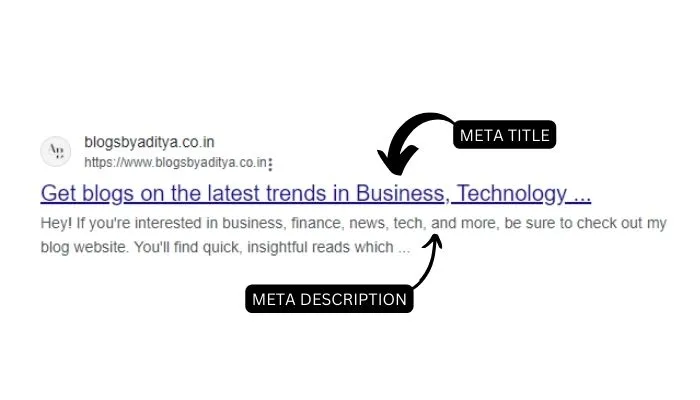Table of Contents
Meta Title Tag

Title tags, also known as meta titles, are a crucial element in the realm of search engine optimization (SEO). They play a significant role in determining how a webpage is perceived by search engines and users alike. In this comprehensive guide, we delve into what meta titles are, why they are important, how to craft effective ones, and their impact on your website’s visibility and click-through rates.
Understanding Meta Title:
In simple terms, a meta title is an HTML element that defines the title of a webpage. It appears as the clickable headline in search engine results pages (SERPs) and is also displayed at the top of a user’s web browser when they visit the page. Meta titles serve as concise summaries of the content on a webpage, providing both search engines and users with an understanding of what the page is about.
Importance of Meta Titles:
Meta titles are crucial for several reasons:
- SEO Ranking: Search engines use meta titles to understand the content of a webpage and determine its relevance to search queries. Well-optimized titles can improve a page’s ranking in search results.
- User Experience: Clear and descriptive meta titles help users understand the content of a webpage before clicking on it, improving the overall user experience.
- Click-Through Rate (CTR): Engaging meta titles can increase the likelihood of users clicking on your website in search results, leading to higher CTRs.
- Crafting Effective Meta Titles:Crafting effective meta titles requires a balance between SEO optimization and user engagement.
Here are some tips for creating compelling titles:
- Be Descriptive: Clearly describe the content of the page in the meta title to ensure users know what to expect.
- Include Keywords: Incorporate relevant keywords that users are likely to search for. However, avoid keyword stuffing, as this can harm your SEO efforts.
- Keep it Concise: Aim for a title length of around 50-60 characters to ensure it displays properly in search results without being cut off.
- Be Unique: Each page on your website should have a unique meta title that accurately reflects its content.
- Add Branding: If appropriate, include your brand name in the meta title to improve brand recognition.
Impact on Visibility and CTR:
Well-crafted meta titles can have a significant impact on your website’s visibility and CTR:
- Visibility: Optimized meta titles can improve your website’s visibility in search results, increasing the likelihood of attracting organic traffic.
- CTR: Engaging meta titles that accurately represent the content of a page can entice users to click on your website, leading to higher CTRs and potentially more conversions.
Best Practices for Meta Titles:
To maximize the effectiveness of your meta titles, consider the following best practices.
- Regular Review: Regularly review and update your meta titles to ensure they remain relevant and optimized for search engines and users.
- A/B Testing: Experiment with different variations of meta titles to determine which ones perform best in terms of CTR and SEO.
- Avoid Duplicates: Each page should have a unique meta title to avoid confusion and ensure that search engines can properly index your content.
- Use Pipes or Hyphens: Consider using pipes (|) or hyphens (-) to separate different elements within the meta title, such as keywords and branding.
Meta titles are a critical component of SEO and user experience. By crafting descriptive, engaging titles that accurately represent your content, you can improve your website’s visibility in search results and attract more clicks from users. Remember to keep your titles concise, include relevant keywords, and regularly review and update them to maintain their effectiveness over time. With strategic optimization, meta titles can significantly contribute to the success of your website.
Meta titles are not only important for search engines but also for users. They provide a glimpse into the content of a webpage, helping users decide whether to click through or not. As such, they play a crucial role in driving traffic and improving the overall performance of a website.
In addition to crafting compelling meta titles, it’s essential to consider the broader context of your SEO strategy. Meta titles work in conjunction with other elements such as meta descriptions, headers, and quality content to create a cohesive user experience and signal relevance to search engines.
As search engine algorithms evolve, so do the best practices for meta titles. Staying informed about the latest trends and updates in SEO can help you adapt your approach and maintain a competitive edge in search results.
Remember, the goal of meta titles is not just to rank higher in search results but also to attract clicks and ultimately conversions. By prioritizing user intent and providing valuable content, you can create meta titles that resonate with your target audience and drive meaningful engagement.
Meta titles are a fundamental aspect of SEO that shouldn’t be overlooked. By following best practices, regularly reviewing and optimizing your titles, and staying abreast of industry changes, you can harness the power of meta titles to enhance your website’s visibility, attract more visitors, and achieve your business goals.
Examples of Effective Meta Titles:
To illustrate the concepts discussed, let’s examine a few examples of effective meta titles across different industries:
- E-commerce: “Shop the Latest Trends in Fashion | Your Favorite Fashion Destination”This meta title effectively communicates the content of the webpage (fashion products) and includes a call to action (shop now).
- Blog Post: “10 Tips for Healthy Living | Expert Advice for a Balanced Lifestyle”This meta title highlights the topic of the blog post (healthy living tips) and establishes authority by mentioning “expert advice.”
- Service Page: “Professional Web Design Services | Transform Your Online Presence Today”Here, the meta title clearly indicates the service offered (web design) and encourages action with the phrase “transform your online presence.”
By analyzing these examples, you can see how effective meta titles can vary depending on the type of content and the desired outcome.
What is Meta description.
A meta description is an HTML attribute that provides a brief description of the content of a webpage. It typically appears below the title tag in search engine results. While meta descriptions don’t directly influence search engine rankings, they play a crucial role in attracting users to click on your link.
Why are Meta Descriptions Important?
- Improved Click-Through Rates (CTR): A compelling meta description can entice users to click on your link by giving them a glimpse of what they’ll find on your page. This can lead to higher CTRs, which are favorable for SEO.
- Enhanced User Experience: Meta descriptions help users determine the relevance of a webpage to their search query. When they see a concise and relevant description, they are more likely to click on the link, resulting in a better user experience.
- Brand Representation: Crafting engaging meta descriptions allows you to showcase your brand’s voice and personality. This can help establish brand identity and attract the right audience to your website.
Example of a Meta Description:
Let’s take an example of a website selling eco-friendly products.
- Title Tag: “Shop Sustainable Eco-Friendly Products – GreenEarth”
- Meta Description: “Discover our wide range of eco-friendly products made from sustainable materials. From reusable bamboo utensils to organic cotton clothing, make a positive impact on the planet with GreenEarth.”
In this example, the meta description provides a clear overview of what the webpage offers – eco-friendly products made from sustainable materials. It highlights key selling points such as the variety of products available and the positive impact on the planet. The language is inviting and aligns with the brand’s values, encouraging users to click through to learn more.
Best Practices for Writing Meta Descriptions:
- Be Concise: Keep your meta descriptions length under 160 characters to ensure they display properly in search results.
- Include Keywords: Incorporate relevant keywords that reflect the content of your webpage and match user search queries.
- Provide Value: Clearly communicate the benefits or unique selling points of your content to entice users to click.
- Maintain Relevance: Ensure that your meta description accurately reflects the content of the webpage to avoid misleading users.
- Call to Action (CTA): Consider including a compelling call to action to prompt users to take the desired action, such as “Shop now,” “Learn more,” or “Discover.”
Conclusion:
In the competitive landscape of digital marketing, every element of your website plays a crucial role in attracting and retaining users. Meta descriptions serve as your website’s first impression in search engine results, making them a valuable tool for improving visibility and driving traffic. By crafting concise, engaging, and relevant meta descriptions, you can increase click-through rates, enhance user experience, and ultimately achieve your online marketing goals.


